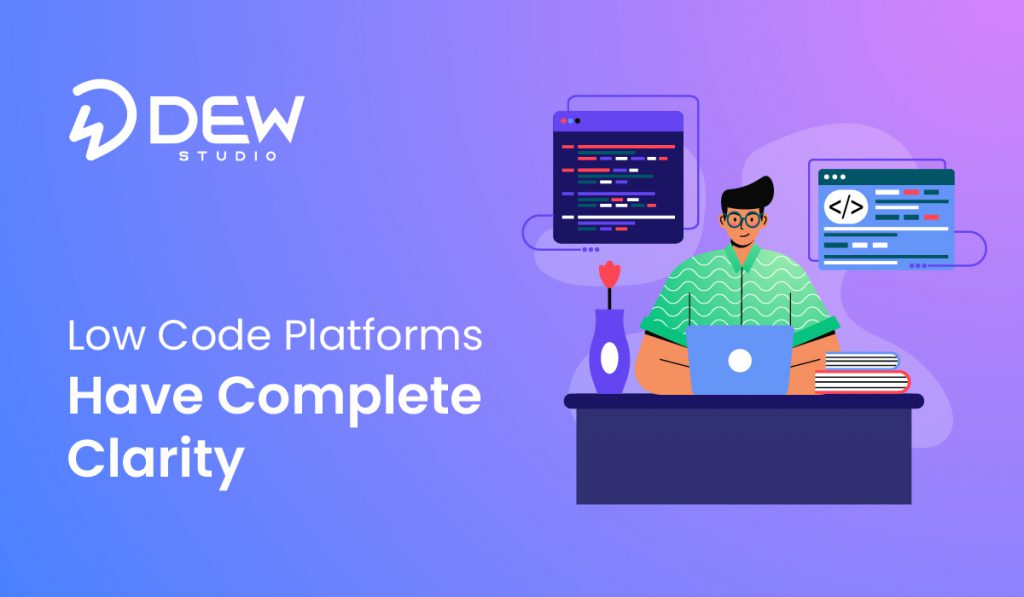
In 2024, we see an exciting combination in web development: Angular and low-code platforms are finding strength together as businesses move to digitize. Together, they present companies with an appealing solution for current development challenges. Angular, which was chosen by 20.9% of professional developers as per Stack Overflow Developer Survey 2023, brings robustness and scalability.
According to Gartner, low-code and no-code (LCNC) platforms will be used in more than 65% of application developments globally by 2024 since they promise rapid development speeds with greater accessibility for rapid application updates. Together, they address the growing demand for faster application delivery by closing skill gaps and improving collaboration among technical and non-technical team members.
In this blog, we will explore why this Angular low-code duo isn’t just another passing trend in web app development—instead, its arrival has the power to radically reshape how software will be developed and deployed through 2024 and beyond.
The Rise of Low Code Development
Let’s first quickly review low-code development and its increasing popularity in recent years before discussing how Angular and low-code development complement each other.
Low-code development platforms enable developers to create applications without manual coding using graphic user interfaces and drag-and-drop components. This results in a quicker turnaround time for working software and a reduction in the level of technical skill needed to create it.
Low-code development has a number of benefits.
- Productive growth and market expansion
- Accelerating time-to-market
- Increasing productivity
- Lowering development costs
- Streamlining maintenance and upgrades
- Bridging the business-IT divide
- Empowering citizen developers.
Enterprises’ pursuit of digital transformation and agility has made low-code platforms appealing.
However, what is the relationship between this trend and Angular, one of the top frameworks for creating single-page applications?
Angular is Still Trending in 2024
Angular has been a vital option for web development companies and individual developers looking to create intricate, feature-rich web apps ever since Google included it in their framework in 2010. This is the reason Angular is still important today:
Robust Ecosystem: Angular provides an effective development environment by providing a wealth of libraries, tools, and third-party connectors that speed up development.
TypeScript Support: Angular provides better code quality for greater reusability and easier maintainability. This is achieved by utilizing TypeScript’s enhanced code quality features, such as better refactoring capabilities and increased maintainability features.
Dependency Injection: Angular’s robust dependency injection architecture promotes testability and modularity, and its CLI and related tools optimize development processes to increase efficiency.
Frequent updates: Google keeps Angular abreast of best practices and web technologies, guaranteeing that its framework is constantly state-of-the-art.
While Angular development has many advantages, creating large-scale applications may be difficult and time-consuming; in these situations, low code is essential.
What Makes Angular With Low-Code Development Optimal Collaboration
Low-code development combined with Angular provides a number of benefits that assist current development teams in getting past many of their obstacles and challenges. This explains why the duopoly is still so powerful today:
1. Quicker Cycles of Development
Angular and other low-code platforms benefit from fast development and prototyping. Developers can quickly create sophisticated functionality by combining Angular’s solid design for core application logic with its prebuilt components and visual tools.
2024 is a significant year because companies will be under increasing pressure to provide efficient and timely digital solutions. By combining Angular with minimal code, teams may achieve tight deadlines without sacrificing quality or scalability.
2. Closing the Skill Divide
Organizations find it difficult to acquire talented Angular developers due to the continued scarcity of web development talents. By enabling less seasoned developers or even citizen developers to contribute to projects using this framework, DEWStudio low-code app development platform can assist enterprises in overcoming this scarcity.
Visual development tools allow non-programmers on the team to work independently on tasks like form creation, user interface design, and basic logic implementation.
3. Enhanced Cooperation
Collaboration tools for improved communication between developers, designers, and business stakeholders are often included in low-code platforms; using this strategy may lead to more successful Angular projects with better results.
Low-code solutions enable business analysts to graphically draw out data models and processes, which Angular developers can then more swiftly execute. In 2024, when remote and scattered teams become the norm, such enhanced cooperation will become even more important.
4. Scalability and Maintainability
Teams may create apps more rapidly while maintaining ease of scaling over time by using low-code development in conjunction with Angular’s modular framework and best practices.
With this hybrid strategy, businesses can benefit from low-code speed and simplicity and Angular’s strength and agility for basic features and advanced operations.
5. Integrate Angular Projects Easily With Current Versions
Numerous businesses have already made large investments in Angular development. Thanks to low-code platforms that facilitate this integration. These companies may improve their present projects without having to make major modifications. Developers can utilize low-code solutions like Adding New Features or Refactoring Parts of Applications while maintaining compatibility with their current codebase.
The year 2024 holds a lot of promise for using this integration feature as companies work to expand and update outdated systems without having to start from scratch.
6. Better Iteration and Prototyping
Because 2024 is going to be such a speedy year, it is more important than ever to prototype ideas quickly. Development teams may quickly create working prototypes using Angular and low-code development platforms, which users or stakeholders can test before making any choices or implementing any plans.
With low-code tools, teams can rapidly prototype functionality and interfaces. These prototypes may then be modified or extended utilizing Angular’s more complex capabilities, resulting in more product alignment and less waste in the development process.
7. Taking Care of the Entire Stack
Even while Angular is primarily focused on front-end development, many low-code platforms also offer full-stack development. This enables developers to quickly set up databases, APIs, and backend services that work well with the front end of an Angular application, increasing developer productivity.
In 2024, front-end and backend development will further converge, making the full-stack strategy even more beneficial.
Final Thoughts
In 2024, Angular and low-code development platforms have proven successful in building online applications. Combining Angular’s stability and scalability with low-code solutions’ speed and accessibility allows users to create apps quickly and efficiently.
Using this hybrid strategy, developers and organizations may remain ahead of the curve and create solutions that keep up with rapidly changing digital environments. DEWStudio, a low-code app development platform, is here to help you with this. Our Angular-Low Code Integrations are going to be popular very soon since they facilitate effective web development cooperation, which will lead to strong web development processes in 2024 and beyond! Connect with us to get the most integrations.
FAQs
Q: How is Low-Code Development Beneficial for Angular Projects?
A: Low-code provides visual tools that facilitate rapid UI creation and simplify data modeling for more focused logic development. This speeds development time and encourages contributions from non-Angular experts, thereby strengthening team collaboration.
Q: Do low-code platforms work seamlessly with existing Angular applications?
A: Yes. Many modern low-code platforms provide seamless integration with existing Angular projects by way of components or modules which can easily be added into an Angular project.
Q: Will using low-code with Angular restrict customization options?
A: No. Most low-code platforms enable developers to extend generated code with custom Angular components and services for improved customization options that enable complex feature implementation with maximum flexibility.
Q: How has the partnership between Angular-low-code and low-code affected team dynamics and roles?
A: It facilitates more collaborative team dynamics by enabling business analysts and citizen developers to contribute directly while experienced Angular developers focus on complex logic and architecture.
Q: Which types of projects benefit the most from using an Angular and low-code combination?
A: Large enterprise apps, projects with changing requirements and rapid prototyping needs, mixed skill team projects, and legacy system modernization efforts tend to gain the most from this pairing.


